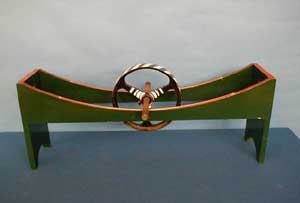Demos: 1Q-12 Wheel on Rough Track

A large wheel with a rough axle of relatively small diameter oscillates on a curved track. The initial potential energy is converted almost completely in to kinetic energy of rotation as a result of the moment of inertia of the small axle being very small compared with that of the much larger wheel. Some small amount of translational kinetic energy is gained because of the change in position of the wheel. Eventually all of the potential energy is converted into work done against friction as the wheel comes to rest.
Directions: Place the axle near one of the ends of the curved track and let it go. After a time, the wheel will come to rest in the center.
Suggestions for Presentation: (This demo is illustrating the concept of conservation of mechanical energy and should perhaps be placed in the 1M section, but because the rotational kinetic energy is the predominant form of kinetic energy, it is placed in this section.) Ask the students what the energy transformation process are when the wheel is allowed to roll down the hill. If the students answer potential to kinetic, further ask what kind of kinetic energy. The wheel clearly isn’t translating very fast, so where does this energy reside? When the wheel comes to rest, clearly potential energy has been lost. Where did it go?
Applications: If a vehicle with large, massive tires were to roll down a hill, it would not gain a lot speed because a good portion of the kinetic energy is tied up in the rotation of the tires.
Last Updated: Nov 30, 2023 11:25 AM